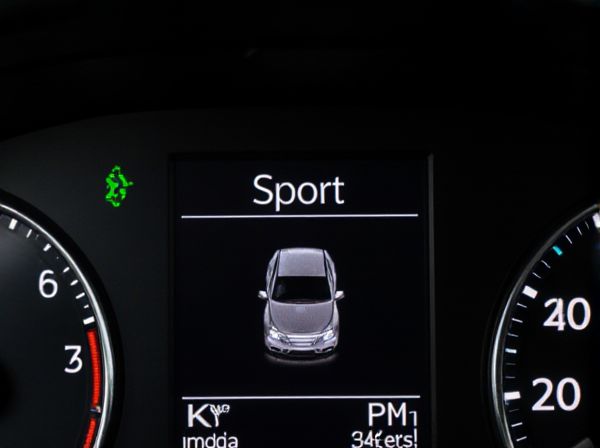
Photo illustration: Eco Driving Indicator vs Sport Mode Indicator
The Eco Driving Indicator helps optimize fuel efficiency by encouraging smoother acceleration and more economical engine performance, reducing emissions and saving fuel costs. In contrast, the Sport Mode Indicator signals a performance-focused setting that enhances throttle response, sharpens steering, and often adjusts transmission behavior for a more engaging and dynamic driving experience. Understanding these indicators allows you to choose between maximizing fuel economy and enjoying spirited driving based on your preferences and road conditions.
Table of Comparison
| Feature | Eco Driving Indicator | Sport Mode Indicator |
|---|---|---|
| Purpose | Promotes fuel-efficient driving habits | Enhances vehicle performance and responsiveness |
| Dashboard Display | Green icon signaling optimal eco-driving | Red icon indicating sport mode activation |
| Effect on Engine | Optimizes throttle and shift patterns for efficiency | Tunes engine for higher power output and quicker acceleration |
| Fuel Consumption | Reduced fuel consumption for cost savings | Increased fuel consumption due to performance focus |
| Driving Experience | Smoother and calmer ride promoting longevity | Sportier, aggressive driving feel |
| Best Use Case | City driving and long-distance cruising | Dynamic driving and overtaking scenarios |
Introduction to Eco Driving Indicators and Sport Mode Indicators
Eco Driving Indicators optimize fuel efficiency by providing real-time feedback on driving habits that reduce fuel consumption and emissions, helping drivers adopt smoother acceleration and braking patterns. Sport Mode Indicators, conversely, enhance vehicle performance by adjusting throttle response, transmission shift points, and steering sensitivity to deliver a more dynamic and aggressive driving experience. Both indicators serve distinct purposes: Eco Driving prioritizes environmental sustainability and cost savings, while Sport Mode focuses on maximizing driving excitement and agility.
Key Differences Between Eco and Sport Mode Indicators
Eco Driving Indicator promotes fuel efficiency by signaling optimal gear shifts and smooth acceleration, aiming to reduce emissions and save fuel. In contrast, Sport Mode Indicator activates performance-oriented settings, enhancing throttle response and transmission behavior for a dynamic driving experience. Key differences lie in their objectives: Eco focuses on maximizing economy, while Sport prioritizes power and handling.
How Eco Driving Indicators Work
Eco Driving Indicators monitor real-time vehicle parameters such as throttle input, acceleration, and fuel efficiency to guide drivers towards economical driving habits, often using visual cues on the dashboard. These systems analyze factors like speed consistency and gear shifts to optimize fuel consumption and reduce emissions. In contrast, Sport Mode Indicators signal enhanced engine responsiveness and performance settings, prioritizing power over fuel economy.
Functionality of Sport Mode Indicators
Sport Mode Indicators enhance driving performance by signaling when the vehicle is in a mode that optimizes throttle response, transmission shifts, and engine output for a dynamic driving experience. These indicators provide real-time feedback that encourages more aggressive acceleration and precision handling, improving vehicle responsiveness. Unlike Eco Driving Indicators that promote fuel efficiency, Sport Mode Indicators focus on maximizing power and control, appealing to performance-oriented drivers.
Benefits of Using Eco Driving Mode
The Eco Driving Indicator promotes fuel-efficient behavior by providing real-time feedback that helps reduce fuel consumption and lower emissions, enhancing environmental sustainability. This mode optimizes engine performance and throttle response to maximize mileage, leading to significant cost savings over time. In contrast, Sport Mode Indicator prioritizes power and acceleration but typically increases fuel usage, making Eco Driving Mode more beneficial for daily commuting and long-term savings.
Performance Advantages with Sport Mode
Sport Mode Indicator enhances vehicle responsiveness by optimizing throttle sensitivity, transmission shift points, and suspension settings, resulting in improved acceleration and dynamic handling. In contrast, the Eco Driving Indicator prioritizes fuel efficiency and smooth engine operation, often limiting performance output. Drivers seeking heightened performance benefits will find Sport Mode more advantageous as it maximizes engine power and driving excitement.
Impact on Fuel Efficiency: Eco vs Sport
The Eco Driving Indicator enhances fuel efficiency by promoting smooth acceleration and optimal gear shifts, reducing fuel consumption significantly during daily commutes. In contrast, the Sport Mode Indicator prioritizes performance by increasing throttle response and engine power, which leads to higher fuel consumption and decreased mileage. Choosing Eco mode over Sport mode can improve fuel economy by up to 15-20%, making it ideal for cost-effective and environmentally conscious driving.
Driving Experience: Comfort vs Performance
The Eco Driving Indicator promotes a smooth and fuel-efficient driving experience by encouraging gradual acceleration and gentle braking, enhancing overall comfort and reducing fuel consumption. In contrast, the Sport Mode Indicator intensifies throttle response, sharpens steering, and often adjusts transmission settings for a more dynamic and performance-oriented drive. Choosing between these modes allows drivers to prioritize either relaxed comfort or exhilarating performance based on their preferences.
When to Use Eco Indicator Mode vs Sport Mode
Eco Driving Indicator Mode is ideal for city commutes and heavy traffic where fuel efficiency and reduced emissions are priorities, promoting smoother acceleration and optimized engine performance. Use Sport Mode Indicator when driving on highways or winding roads that demand quicker throttle response, enhanced acceleration, and improved handling for a dynamic driving experience. Selecting the appropriate mode based on driving conditions maximizes fuel economy or performance, enhancing overall vehicle control and efficiency.
Choosing the Right Driving Mode for Your Needs
Eco Driving Indicator promotes fuel efficiency by encouraging smooth acceleration and optimal engine performance, ideal for reducing fuel consumption and lowering emissions during daily commutes. Sport Mode Indicator enhances vehicle responsiveness by adjusting throttle sensitivity and transmission shifts, providing more dynamic acceleration and handling suited for spirited driving or performance-focused scenarios. Selecting the right driving mode depends on whether maximizing fuel economy or prioritizing driving excitement aligns better with your current driving conditions and personal preferences.
 caratoz.com
caratoz.com